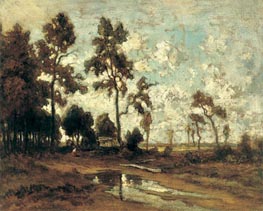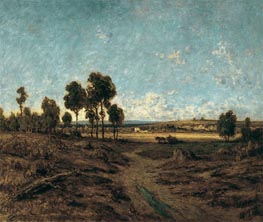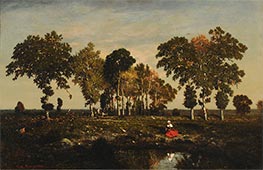
Theodore Rousseau Painting Reproductions 1 of 1
1812-1867
French Barbizon School Painter
Pierre Etienne Theodore Rousseau (April 15, 1812 - December 22, 1867), French painter of the Barbizon school, was born in Paris, of a bourgeois family which included one or two artists.
At first he received a business training, but soon displayed aptitude for painting. Although his father regretted the decision at first, he became reconciled to his son leaving business, and throughout the artist's career (for he survived his son) was a sympathizer with him in all his conflicts with the Paris Salon authorities. Theodore Rousseau shared the difficulties of the romantic painters of 1830 in securing for their pictures a place in the annual Paris exhibition. The whole influence of the classically trained artists was against them, and not until 1848 was Rousseau adequately presented to the public.
He had exhibited one or two unimportant works in the Salon of 1831 and 1834, but in 1836 his great work "La Descente des vaches" was rejected by the vote of the classic painters; and from then until after the revolution of 1848 he was persistently refused. He was not without champions in the press, and under the title of "le grand refuse" he became known through the writings of Thor, the critic who afterwards resided in England and wrote under the name of Burger.
During these years of artistic exile Rousseau produced some of his finest pictures: "The Chestnut Avenue", "The Marsh in the Landes" (now in the Louvre), "Hoar-Frost" (now in America); and in 1851, after the reorganization of the Salon in 1848, he exhibited his masterpiece, "The Edge of the Forest" (also in the Louvre), a picture similar in treatment to, but slightly varied in subject from, the composition called "A Glade in the Forest of Fontainebleau", in the Wallace Collection at Hertford House, London.
Up to this period Rousseau had lived only occasionally at Barbizon, but in 1848 he took up his residence in the forest village, and spent most of his remaining days in the vicinity. He was now at the height of his artistic power, and was able to obtain fair sums for his pictures (but only about one-tenth of their value thirty years after his death), and his circle of admirers increased. He was still ignored by the authorities, for while Narcisse Virgilio Diaz was made Chevalier of the Legion of Honour in 1851, Rousseau was left undecorated at this time, but was nominated shortly afterwards.
At the Exposition Universelle of 1853, where all Rousseau's rejected pictures of the previous twenty years were gathered together, his works were acknowledged to form one of the finest of the many splendid groups there exhibited. But during his lifetime Rousseau never really conquered French taste, and after an unsuccessful sale of his works by auction in 1861, he contemplated leaving Paris for Amsterdam or London, or even New York.
Misfortune then overtook him: his wife, who had been a source of constant anxiety for years, became almost hopelessly insane; his aged father looked constantly to him for pecuniary assistance; his patrons were few. Moreoever, while he was temporarily absent with his invalid wife, a youth living in his home (a friend of his family) committed suicide in his Barbizon cottage; when he visited the Alps in 1863, making sketches of Mont Blanc, he fell dangerously ill with inflammation of the lungs; and when he returned to Barbizon he suffered from insomnia and became gradually weakened. He was elected president of the fine art jury for the 1867 Exposition. His disappointment at being passed over in the distribution of the higher awards told seriously on his health, and in August he was seized with paralysis. He slightly recovered, but was again attacked several times during the autumn. Finally, in November, he began to sink, and he died, in the presence of his lifelong friend, Jean-Francois Millet, on December 22, 1867.
Rousseau's other friend and neighbor, Jules Dupre, himself an eminent landscape painter of Barbizon, relates the difficulty Rousseau experienced in knowing when his picture was finished, and how he, Dupre, would sometimes take away from the studio some canvas on which Rousseau was laboring too long. Millet, the peasant painter, for whom Rousseau had the highest regard, was much with him during the last years of his life. Rousseau was a good friend to Diaz, teaching him how to paint trees, for up to a certain point in his career Diaz considered he could only paint figures.
Rousseau's pictures are always grave in character, with an air of exquisite melancholy which is powerfully attractive to the lover of landscapes. They are well finished when they profess to be completed pictures, but Rousseau spent so long a time in working up his subjects that his absolutely completed works are comparatively few. He left many canvases with parts of the picture realized in. detail and with the remainder somewhat vague; and also a good number of sketches and water-color drawings. His pen work in monochrome on paper is rare; it is particularly searching in quality. There are a number of fine pictures by him in the Louvre, and the Wallace collection. contains one of his most important Barbizon pictures. There is also an example in the Ionides collection at the Victoria and Albert Museum.
At first he received a business training, but soon displayed aptitude for painting. Although his father regretted the decision at first, he became reconciled to his son leaving business, and throughout the artist's career (for he survived his son) was a sympathizer with him in all his conflicts with the Paris Salon authorities. Theodore Rousseau shared the difficulties of the romantic painters of 1830 in securing for their pictures a place in the annual Paris exhibition. The whole influence of the classically trained artists was against them, and not until 1848 was Rousseau adequately presented to the public.
He had exhibited one or two unimportant works in the Salon of 1831 and 1834, but in 1836 his great work "La Descente des vaches" was rejected by the vote of the classic painters; and from then until after the revolution of 1848 he was persistently refused. He was not without champions in the press, and under the title of "le grand refuse" he became known through the writings of Thor, the critic who afterwards resided in England and wrote under the name of Burger.
During these years of artistic exile Rousseau produced some of his finest pictures: "The Chestnut Avenue", "The Marsh in the Landes" (now in the Louvre), "Hoar-Frost" (now in America); and in 1851, after the reorganization of the Salon in 1848, he exhibited his masterpiece, "The Edge of the Forest" (also in the Louvre), a picture similar in treatment to, but slightly varied in subject from, the composition called "A Glade in the Forest of Fontainebleau", in the Wallace Collection at Hertford House, London.
Up to this period Rousseau had lived only occasionally at Barbizon, but in 1848 he took up his residence in the forest village, and spent most of his remaining days in the vicinity. He was now at the height of his artistic power, and was able to obtain fair sums for his pictures (but only about one-tenth of their value thirty years after his death), and his circle of admirers increased. He was still ignored by the authorities, for while Narcisse Virgilio Diaz was made Chevalier of the Legion of Honour in 1851, Rousseau was left undecorated at this time, but was nominated shortly afterwards.
At the Exposition Universelle of 1853, where all Rousseau's rejected pictures of the previous twenty years were gathered together, his works were acknowledged to form one of the finest of the many splendid groups there exhibited. But during his lifetime Rousseau never really conquered French taste, and after an unsuccessful sale of his works by auction in 1861, he contemplated leaving Paris for Amsterdam or London, or even New York.
Misfortune then overtook him: his wife, who had been a source of constant anxiety for years, became almost hopelessly insane; his aged father looked constantly to him for pecuniary assistance; his patrons were few. Moreoever, while he was temporarily absent with his invalid wife, a youth living in his home (a friend of his family) committed suicide in his Barbizon cottage; when he visited the Alps in 1863, making sketches of Mont Blanc, he fell dangerously ill with inflammation of the lungs; and when he returned to Barbizon he suffered from insomnia and became gradually weakened. He was elected president of the fine art jury for the 1867 Exposition. His disappointment at being passed over in the distribution of the higher awards told seriously on his health, and in August he was seized with paralysis. He slightly recovered, but was again attacked several times during the autumn. Finally, in November, he began to sink, and he died, in the presence of his lifelong friend, Jean-Francois Millet, on December 22, 1867.
Rousseau's other friend and neighbor, Jules Dupre, himself an eminent landscape painter of Barbizon, relates the difficulty Rousseau experienced in knowing when his picture was finished, and how he, Dupre, would sometimes take away from the studio some canvas on which Rousseau was laboring too long. Millet, the peasant painter, for whom Rousseau had the highest regard, was much with him during the last years of his life. Rousseau was a good friend to Diaz, teaching him how to paint trees, for up to a certain point in his career Diaz considered he could only paint figures.
Rousseau's pictures are always grave in character, with an air of exquisite melancholy which is powerfully attractive to the lover of landscapes. They are well finished when they profess to be completed pictures, but Rousseau spent so long a time in working up his subjects that his absolutely completed works are comparatively few. He left many canvases with parts of the picture realized in. detail and with the remainder somewhat vague; and also a good number of sketches and water-color drawings. His pen work in monochrome on paper is rare; it is particularly searching in quality. There are a number of fine pictures by him in the Louvre, and the Wallace collection. contains one of his most important Barbizon pictures. There is also an example in the Ionides collection at the Victoria and Albert Museum.
4 Theodore Rousseau Paintings

The Collier's Hut in the Forest of Fontainebleau c.1855
Oil Painting
$566
$566
Canvas Print
$49.27
$49.27
SKU: RTH-5683
Theodore Rousseau
Original Size: 34.2 x 42 cm
Thyssen-Bornemisza Museum, Madrid, Spain
Theodore Rousseau
Original Size: 34.2 x 42 cm
Thyssen-Bornemisza Museum, Madrid, Spain

View of the Pain of Montmartre c.1848
Oil Painting
$928
$928
Canvas Print
$62.99
$62.99
SKU: RTH-5684
Theodore Rousseau
Original Size: 59.5 x 72 cm
Thyssen-Bornemisza Museum, Madrid, Spain
Theodore Rousseau
Original Size: 59.5 x 72 cm
Thyssen-Bornemisza Museum, Madrid, Spain

The Pond c.1842/43
Oil Painting
$967
$967
Canvas Print
$49.27
$49.27
SKU: RTH-18881
Theodore Rousseau
Original Size: 41 x 63.3 cm
Musee des Beaux Arts, Reims, France
Theodore Rousseau
Original Size: 41 x 63.3 cm
Musee des Beaux Arts, Reims, France

The Watering Place n.d.
Oil Painting
$607
$607
Canvas Print
$49.27
$49.27
SKU: RTH-18882
Theodore Rousseau
Original Size: 41.7 x 63.6 cm
Musee des Beaux Arts, Reims, France
Theodore Rousseau
Original Size: 41.7 x 63.6 cm
Musee des Beaux Arts, Reims, France